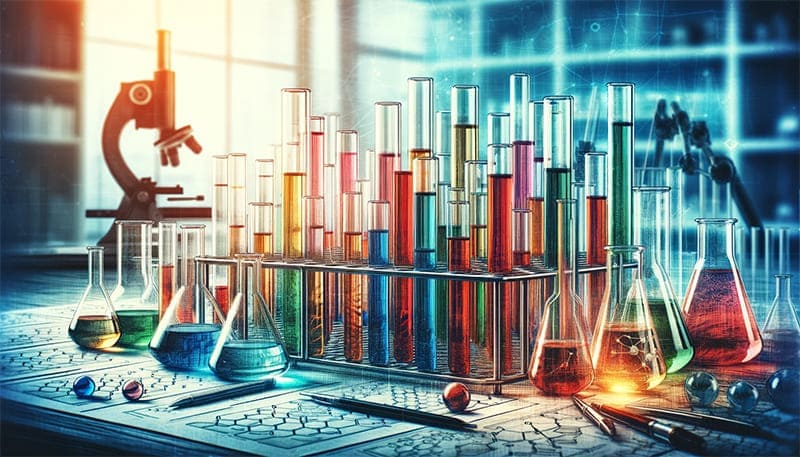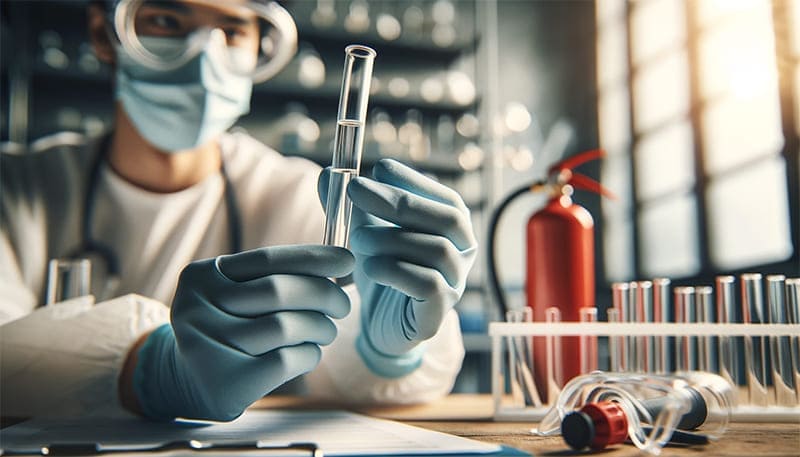Have you ever wondered about the sleek, transparent tubes in every science lab picture? What makes these simple glass tools so indispensable to modern science? Imagine a world teetering on the brink of new discoveries, where each clear cylinder holds a universe of possibilities.
Glass test tubes are more than mere containers; they are the silent allies of every scientific endeavor. “Revolutionizing Reactions: The Art and Science of Using Glass Test Tubes” delves into how these tubes aren’t just vessels but vital instruments that shape the way we understand the chemical and biological world.
Curious yet? Let’s dive in deeper.

Why Are Glass Test Tubes Essential in Laboratories
Glass Test Tubes have been fundamental in experimental science due to their ability to withstand heat, resist chemical corrosion, and provide clear visibility. But why glass, specifically? This question circles back to the remarkable properties of glass itself, including its thermal resistance, chemical inertness, and transparency, making it an exemplary material for observational and reactive purposes in scientific experiments.
What Revolution Has Glass Brought in Scientific Reactions
The usage of glass test tubes has revolutionized scientific reactions in numerous ways. Firstly, the thermal stability of glass allows for the direct heating of tubes, making them ideal for reactions requiring specific temperatures. Secondly, their inert nature ensures that the material of the tube does not interfere with the reactions occurring within. Lastly, the transparency of glass allows for easy monitoring of the reaction process, a critical aspect in experimental science.
How Has the Design of Glass Test Tubes Evolved
The design of glass test tubes has evolved significantly over the years, adapting to the varied needs of scientific research. From simple, straight, open-topped tubes to ones with screw caps, colored markings, and graduated scales, each design enhancement has added a layer of functionality and ease. Researchers can choose from a variety of sizes and forms depending on the nature of their work, making glass test tubes a versatile tool in any lab setting.

What Are the Safety Measures When Using Glass Test Tubes
When using glass test tubes, safety is paramount. Proper handling, avoiding thermal shock by gradually changing temperatures, and using protective equipment like tongs and goggles are essential. It’s also crucial to understand the different types of glass, as some are designed to withstand higher pressures and temperatures, reducing the risk of accidents in the lab.
How Are Glass Test Tubes Impacting Environmental Sustainability
In the realm of environmental sustainability, glass test tubes offer a significant advantage due to their reusability and recyclability. Unlike single-use plastics, glass can be cleaned and sterilized for repeated use, reducing waste. Additionally, glass manufacturing has seen improvements in reducing energy consumption and minimizing waste, further enhancing the environmental footprint of using glass in scientific settings.
What Future Innovations Are Expected in Glass Test Tube Technology
The future of glass test tube technology is promising, with innovations aimed at enhancing durability, resistance, and functionality. Advances in material science could lead to even more resilient glass types, capable of withstanding extreme conditions. Additionally, integrating technology like QR codes for easy identification and tracking of samples is on the horizon, further revolutionizing the role of glass test tubes in scientific research.

How Can One Choose the Right Glass Test Tube for Their Needs
Choosing the right glass test tube involves understanding the specific requirements of your experiment. Consider factors like temperature resistance, chemical compatibility, and the physical properties needed, such as size and shape. Consulting with manufacturers and experienced scientists can provide valuable insights into selecting the most suitable type for your particular application.
Are Glass Test Tubes Adapting to Modern Laboratory Needs
As science progresses, so do the requirements of the laboratories. Glass test tubes are no exception to this evolution. They have become more specialized, catering to the diverse and complex needs of modern research. Today, test tubes are available with coatings for UV protection, markings for measurement, and even treated surfaces for specific types of chemical reactions. This adaptability ensures that glass test tubes remain at the forefront of scientific research, evolving with the needs of the scientists who rely on them.
How Do Glass Test Tubes Contribute to Education and Learning
Glass test tubes are not just limited to high-tech laboratories; they are also a staple in educational institutions. Their use in schools and universities as a hands-on learning tool is invaluable. Students learn about chemical reactions, biological processes, and even physics principles through the clear walls of these tubes. By enabling practical experiments, glass test tubes help illuminate scientific concepts, fostering a deeper understanding and appreciation for science among students of all ages.

What Are the Economic Implications of Using Glass Test Tubes
Considering the economic aspect, glass test tubes are cost-effective in the long run. Their durability and reusability mean that they don’t need to be replaced frequently, unlike disposable alternatives. The initial investment in high-quality glass can save money and reduce waste over time. Moreover, as demand for environmentally sustainable lab equipment grows, the value of using recyclable materials like glass only increases, positively impacting both laboratory budgets and the environment.
The Intersection of Art and Science in Glass Test Tubes
Interestingly, the use of glass test tubes transcends the scientific realm, entering the world of art and decor. Artists and designers have repurposed these scientific instruments into vases, chandeliers, and even architectural elements. This crossover highlights the aesthetic appeal of glass test tubes, celebrating their clear, minimalist design. It’s a beautiful reminder of how science and art are interconnected, each inspiring innovation in the other.
What Are Some Unconventional Uses of Glass Test Tubes
Beyond the laboratory and the classroom, glass test tubes find themselves in various unconventional roles. In the culinary world, they serve as unique containers for spices or infusions. In event planning, they become part of creative decor or favors. Even in the beauty industry, test tubes are used to package small samples of products. These alternative applications demonstrate the versatility and enduring appeal of glass test tubes in various aspects of daily life.

Glass Test Tubes and the Digital Age
With the advent of the digital age, even the traditional glass test tube has seen technological integration. RFID tags, barcodes, and even digital sensors are being incorporated into these tubes, allowing for automated data collection and tracking. This technological leap not only enhances the accuracy and efficiency of experiments but also paves the way for more integrated and intelligent laboratory systems.
What Challenges Face Glass Test Tube Production and Usage
Despite their many advantages, glass test tubes face challenges in production and usage. The manufacturing process requires precise control and high-quality materials to ensure the tubes meet safety and performance standards. Additionally, handling and disposal of broken glass require careful protocol to avoid injury and contamination. As the demand for more specialized and durable glass increases, so does the challenge of producing it cost-effectively and sustainably.
Navigating Regulatory and Quality Standards for Glass Test Tubes
In the world of scientific research, quality and precision are paramount. Glass test tubes must adhere to strict regulatory and quality standards to ensure safety and efficacy in their use. These standards, often set by international organizations and government bodies, dictate the composition, strength, and cleanliness of the glass. Laboratories and manufacturers must navigate these regulations carefully, ensuring that each test tube meets the exacting requirements necessary for scientific work. This commitment to quality ensures that researchers can trust the integrity of their tools and the validity of their results.
The Role of Glass Test Tubes in Groundbreaking Research
Throughout history, glass test tubes have been at the center of numerous groundbreaking scientific discoveries. They have held the chemicals that led to the development of new medicines, the biological samples that unlocked the secrets of DNA, and the novel materials that have revolutionized industries. Each of these milestones underscores the critical role of glass test tubes in scientific advancement. Their continued use in cutting-edge research promises a future of exciting discoveries and innovations, with glass test tubes quietly supporting the relentless pursuit of knowledge.

Optimizing Laboratory Efficiency with Glass Test Tubes
Efficiency is a key concern in any laboratory setting. Glass test tubes contribute significantly to streamlined operations. Their uniformity allows for easy integration with automated systems, reducing manual handling and minimizing errors. The clear glass enables quick visual inspections, speeding up qualitative assessments. Additionally, their durability and reusability lead to reduced waste and lower costs. By optimizing the everyday tools of the trade, laboratories can focus more on the science and less on the logistics.
The Environmental Impact of Glass Test Tube Manufacturing
While glass test tubes are reusable and recyclable, their production is not without environmental impact. The manufacturing process is energy-intensive, requiring high temperatures to melt and mold the glass. There is also the matter of transportation and the associated carbon footprint, given that glass is heavier than alternative materials like plastic. However, advances in manufacturing technology and increasing focus on sustainable practices are helping to reduce these impacts. More efficient furnaces, increased use of recycled glass, and improvements in logistics are all contributing to a more environmentally friendly glass industry.
Global Access and Availability of Glass Test Tubes
Glass test tubes are a global commodity, used by laboratories around the world. However, access and availability can vary significantly, impacting the quality and progress of research in different regions. Efforts to standardize quality, coupled with initiatives to improve distribution channels, are crucial in ensuring that all researchers have access to the high-quality glass test tubes they need. International collaborations and trade agreements play a key role in this, helping to bridge the gap between manufacturers and end-users worldwide.
Conclusion
As we stand on the cusp of new scientific frontiers, the role of glass test tubes in revolutionizing reactions and understanding remains undiminished. Their journey from simple containers to bearers of groundbreaking reactions is a story of human ingenuity and relentless curiosity. Let’s continue to explore, innovate, and educate, harnessing the humble test tube’s potential to unlock the mysteries of the universe. Dive deeper, question relentlessly, and join the revolution in scientific discovery with every glass tube you hold!










